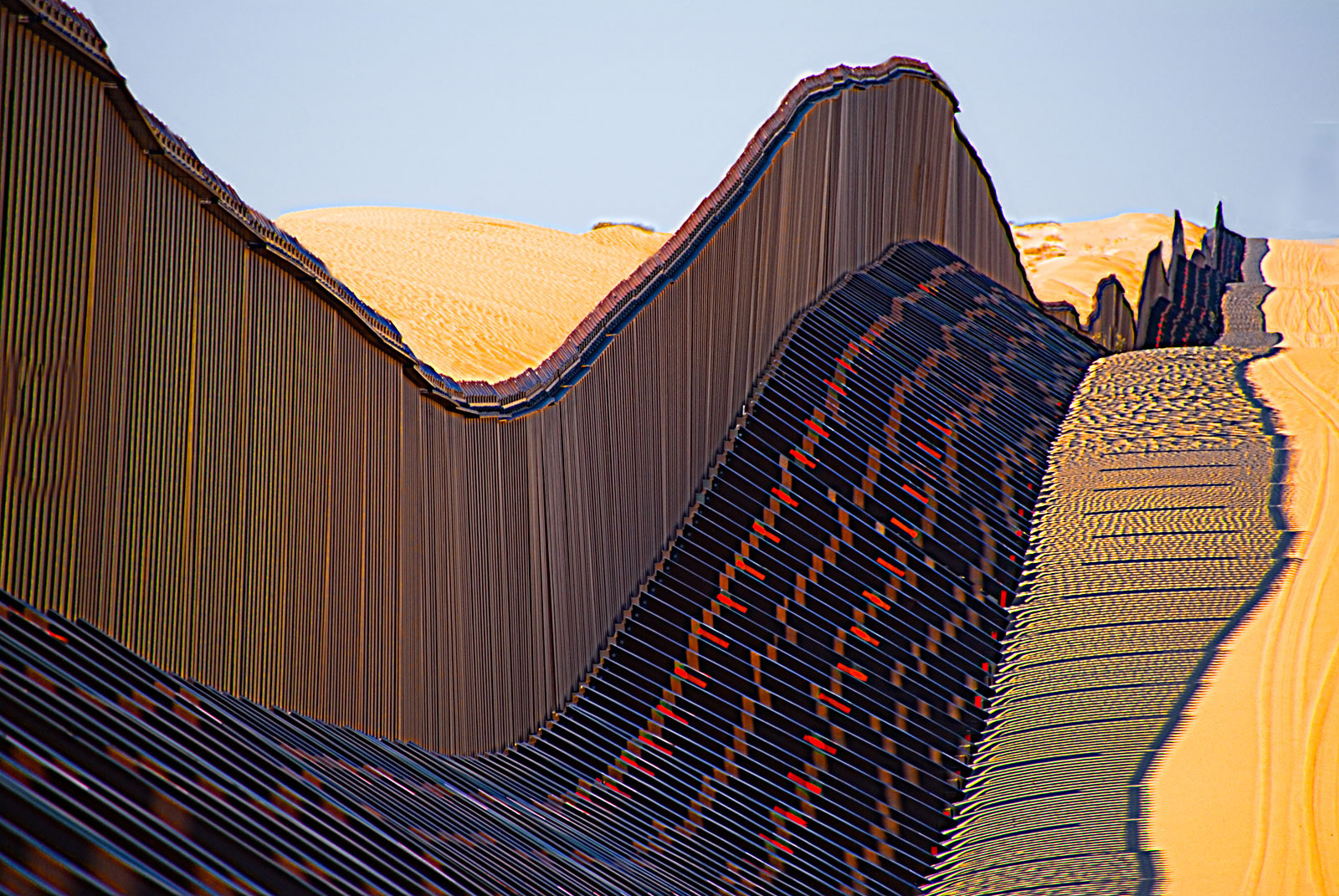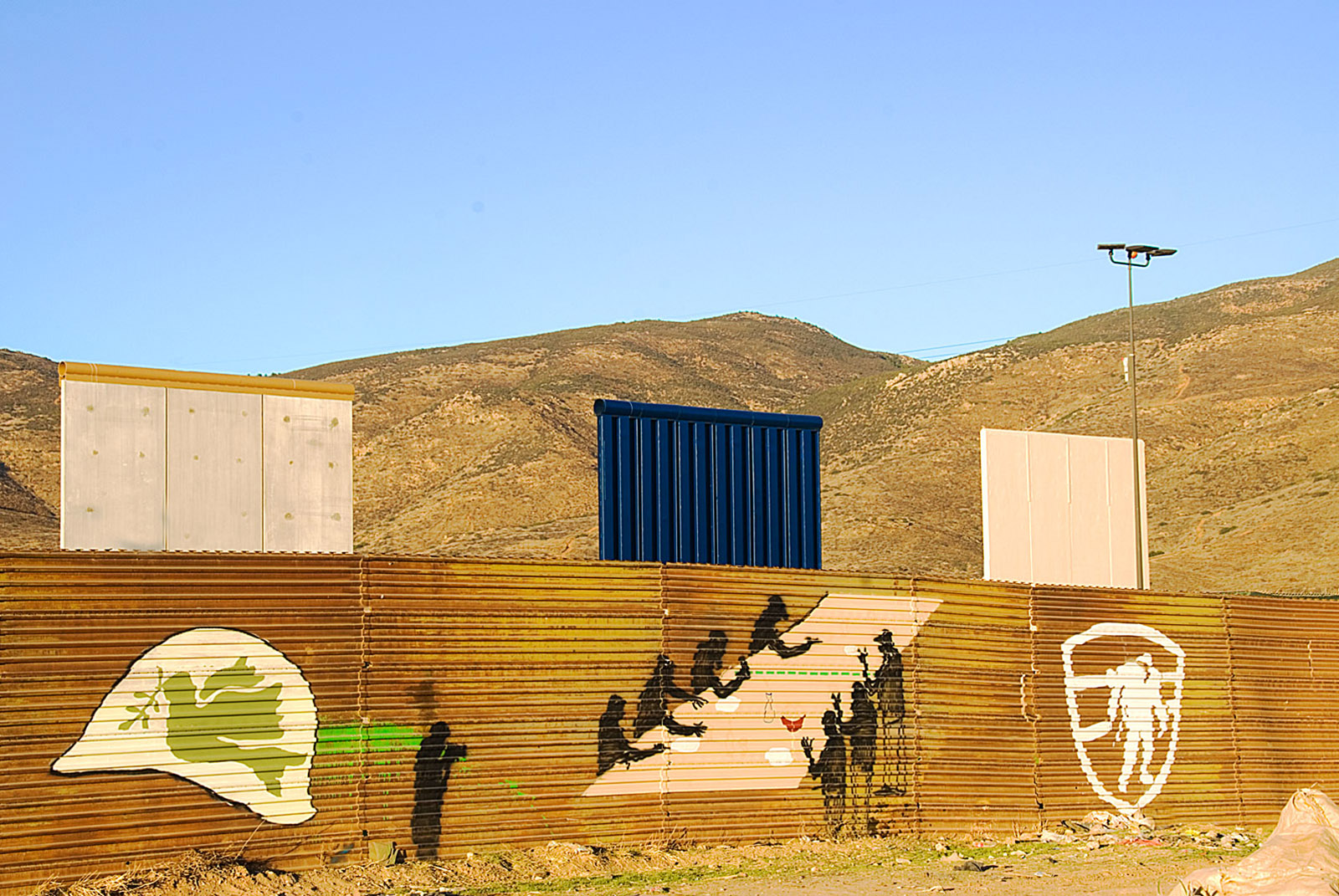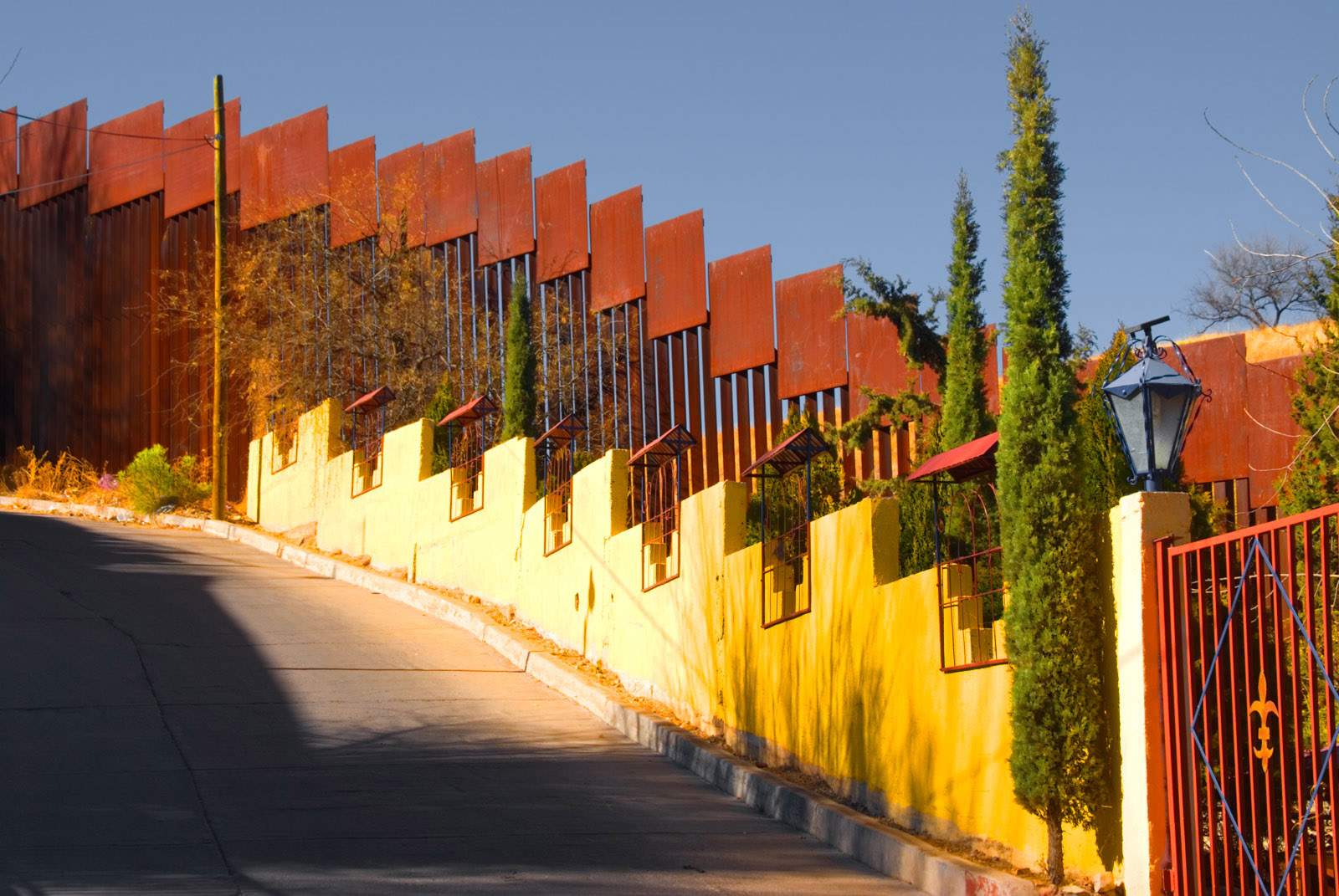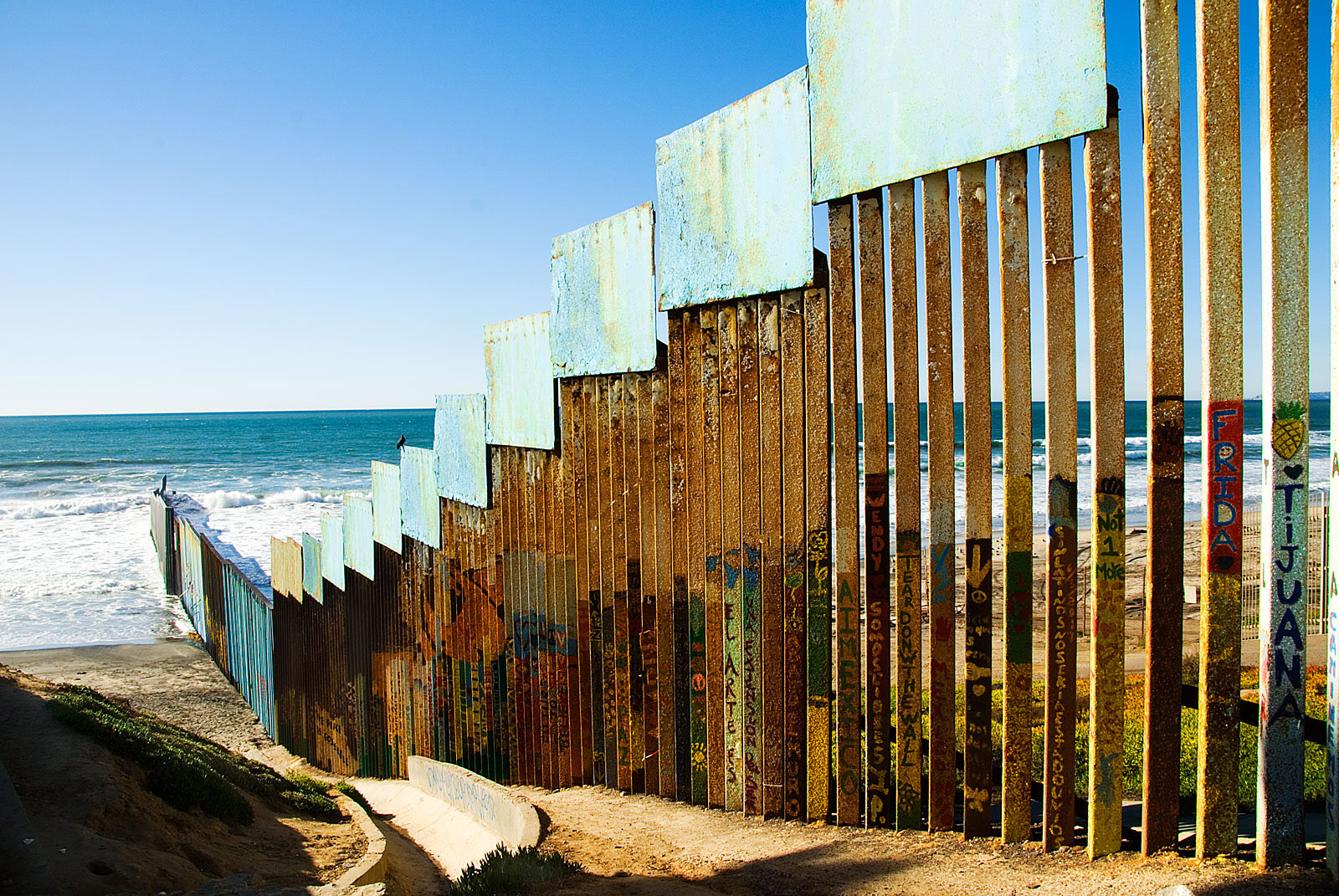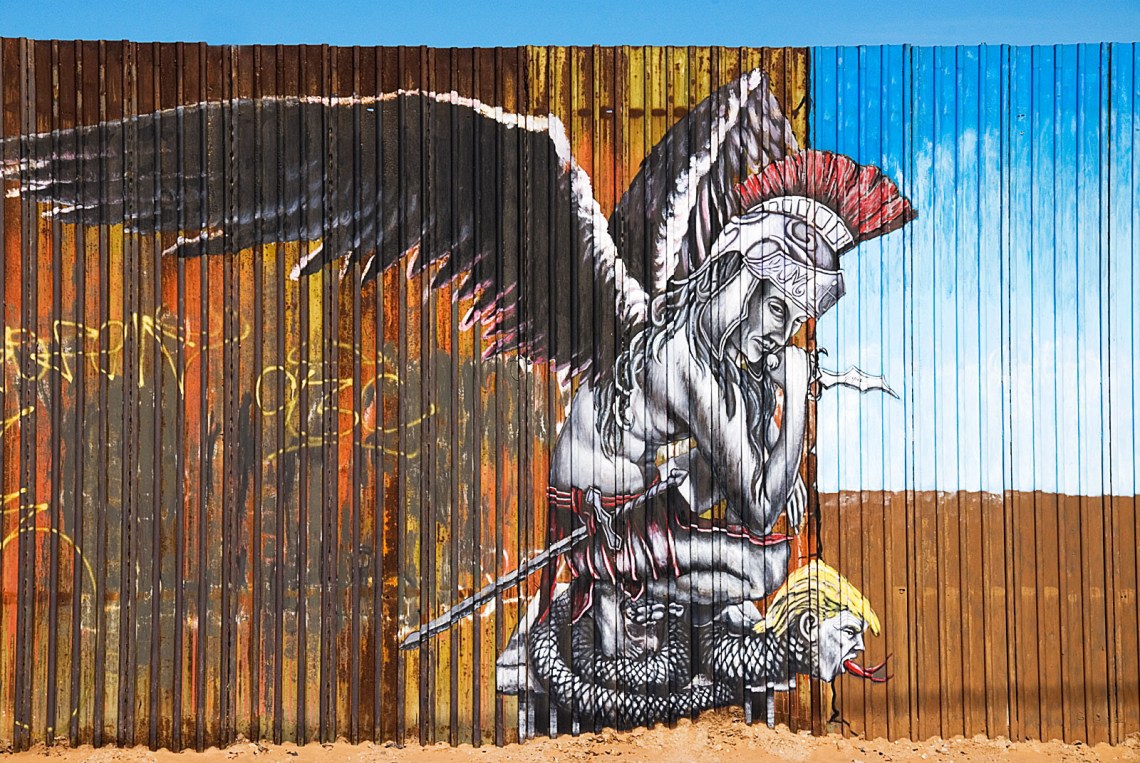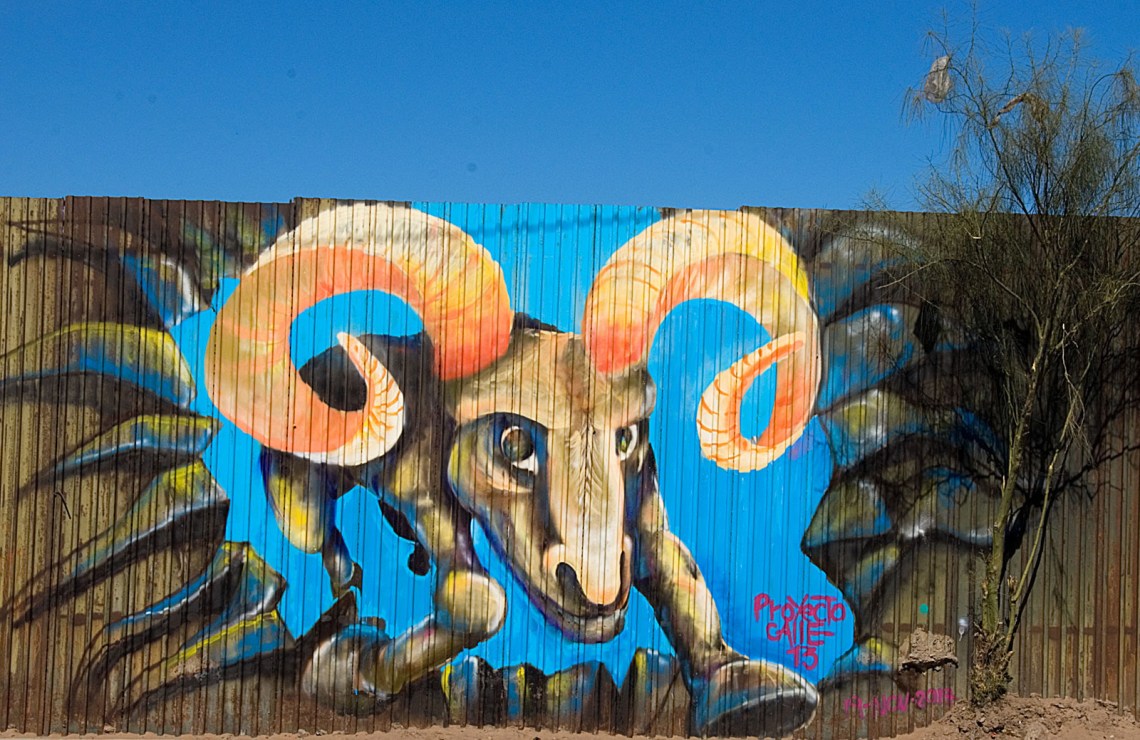The eight prototypes of the wall that Donald Trump wants to build between the US and Mexico stand in San Diego like the mysterious monolith from Stanley Kubrick’s 2001: A Space Odyssey—sentinels guarding the border. Their powers must be extraterrestrial, since no merely human structures can be expected to kill the spirit of hope—or desperation—that drives so many people to risk their lives on the road to El Norte. Christoph Büchel, an artist of Swiss-Finnish parentage who now lives in Iceland, has cheekily proposed that the prototypes be designated a US national monument and protected from demolition as objects of “significant cultural value” under the 1906 Antiquities Act. “This is a collective sculpture,” he says. The prototypes are, as The New York Times paraphrased his view, “an unintended sculpture garden willed into existence by the president and his supporters.” Even if the border wall is never built, says Büchel, the sample sections “need to be preserved because they can signify and change meaning through time.”
We were determined to document them for an exhibition of Ianthe Ruthven’s work that will be held at the Royal Geographical Society in London in October, but our friends in San Diego, Paul and David, told us there was no way we could photograph the structures from the American side: the construction site is off-limits, surrounded by razor wire, and cannot be viewed without Border Patrol approval. Getting the permits would mean contacting the authorities in Washington—and permission would be very far from being guaranteed for a show with the working title “KEEP OUT! Barriers and Boundaries: Ancient and Modern.” Instead, David’s friend Gonzalo, a journalist by trade, would take us to the Tijuana side of the border to see the prototypes, as well as other, existing sections of the border fence.
It was a Monday morning when Gonzalo picked us up from the border crossing. Affable and Anglophone, he was keen to share his knowledge of, and enthusiasm for, his native city. San Diego and Tijuana, he told us, is a story of two sisters: “San Diego is the northern beauty, statuesque and elegant. Tijuana may be the ugly one but she knows how to dance.” He drove us through streets past a number of streamlined factories. (“We [Mexicans] are number one in the world for assembling TVs,” he told us. “They build the TVs and re-export them, but don’t make any of the parts. Everything has to go back to the US, even off-cuts and shavings.”) We left the paved road and carried on through a labyrinth of cratered streets, where eighteen-wheel trucks churned up waves of dust as they prepared to enter the border crossing reserved for freight. Eventually, we came to a cacophonous breakers’ yard where men were dismembering sections of trucks and cars with crowbars and hammers.
In order to shoot the prototypes erected on the other side of the fence, Ianthe had to evade a mangy-looking dog with three legs. “Watch out!” I called. “It might have rabies!” It barked and whined while she scrambled up a heap of scrap metal to perch precariously on the frosted remains of what was once the windshield of a tractor cab.
The eight huge slabs, about thirty-foot wide by thirty-foot high, made variously of concrete, steel, and composite materials, and designed to withstand assaults from hammers and blowtorches, as well as to impede anyone trying to climb them with ladders and ropes, are hardly “beautiful.” But they are certainly formidable, especially if one imagines any one of them attached to thousands of other panels of like design stretching over more than 700 miles of mountain, desert, fields, and scrub. The prototypes’ pristine condition and vast dimensions made the sections of existing barrier bordering the junkyard where we stood appear suddenly flimsy and dilapidated, with their rusting segments and footings amid piles of garbage.
Surrounded by the detritus of scrap, I was reminded of the great Hieronymus Bosch triptych in the Prado gallery in Madrid. Was this junkyard perhaps an automotive hell where bad, inoperable vehicles are subjected to demonic destruction by the breakers, while the good, working trucks enjoy the serenity and calm of automotive paradise? The latter, it so happened, was the RV resort on the Chula Vista Bayfront, only about five miles from the US-Mexico border, where we were staying in a motorhome we had rented for our trip. Other vehicles, more luxurious and cumbersome than ours, as big as London buses, with names like Bounder, Cheetah, Hurricane, and Zephyr, nestled behind neatly trimmed hedges. Many of the people who occupy the gated resort, a receptionist told us, are “snowbirds” who migrate from Canada and northern states to benefit from California’s clement winters. The snowbirds, we noted, were mostly elderly and, unsurprisingly, white. As RV novices, we need assistance, and the Latino maintenance man who connected us to vital services (water, sewage, power, and cable TV) was always smiling. When doing his rounds, he gave a friendly wave from his electric cart. For so many south of the border, happiness is the pursuit of El Norte, where the maintenance man, legal, documented, untroubled by officialdom, appeared to have found his terrestrial niche.
Advertisement
“Before 9/11 things were much easier,” Gonzalo told us as we drove toward the ocean. “I used to cross every week—just to get milk or go to the laundromat, grab some groceries, and come back. You never had to wait for more than half an hour at the border. After 9/11, the delay was two to three hours. It’s getting better now, but not like it was. They use 9/11 as an excuse to keep people out. They are being racist: ‘Brown people are attacking us. Circle the wagons!’ But they still need us to work in their fields.”
We stopped on a busy highway looking down over the airport where the old rusty fence dips sharply into a valley before cascading toward the sea. Near the airport, Gonzalo told us, the people smugglers—known as coyotes—used to dig tunnels. One that he saw when covering the story for his paper was large enough for a car to pass through. The coyotes and drug smugglers had industrial tunneling equipment. If a tunnel became flooded, they used industrial pumps. On the US side, the tunnels issued into a storage area, where office space could be rented by the coyotes’ associates. The tunnels were used by the dealers at a time when Tijuana’s drug wars were at their height, in 2006 and 2007. Francisco Cantú, a former Border Patrol agent of mixed Mexican-American ancestry and the author of The Line Becomes a River, a lyrical and poignant account of the border, writes of morgues overflowing with bodies in Tijuana and Juarez, where “the cycle of violence was so tightly looped, so unending, that cartel members often raided morgues, reclaiming the bodies of victims, comrades and leaders.”
President Felipe Calderón, elected in 2006 on a promise to “clean up the streets,” claimed that more than 90 percent of the dead were “criminals,” but many experts disagree, including Professor Molly Molloy of New Mexico State University, who studies violence in the borderlands and writes, “The overwhelming majority of the victims are ordinary people and that most of them are poor: children, teenagers, old people, small-business proprietors who refused to pay extortion demands, mechanics, bus drivers… boys selling newspapers.” In 2015, the Mexican government released data officially recognizing as homicides more than 164,000 deaths between 2007 and 2014. But, as Molloy has noted and The Washington Post reported, this figure did not account for an additional 25,000 people reported “missing or disappeared” from 2006 to 2012.
Things in Tijuana have improved since that time, but at some cost. With marijuana now partially legalized in California, the traffic appears to be flowing in the opposite direction. The more the drug is legalized in the US, the less profitable it will be for the cicadas, or dealers, said Gonzalo, but that won’t stop them. The partial legalization will drive down the cost of the illegal stuff, with consequences that may be just as dire. The same market logic applies to the coyotes in places like Tijuana, where the border controls have been tightened. Smaller tunnels used to be an option. People could crawl through concrete pipes used for channeling the water of a small river. But now the Border Patrol has built a second fence on the US side, so anyone who tried to use this method would end up between the two fences, in a no man’s land on US soil. This may slow the local traffic in people, but it may also increase their value as commodities. As Cantú put it: “Every surge in border enforcement has brought a corresponding increase to the yield potential of each prospective migrant.”
We drove past the airport and toward the sea. The American side is undulating scrubland intersected by concrete water channels and dirt roads that are used by the white jeeps of the US Border Patrol. The Mexican side is a myriad of small streets that lead up to the older rusty fence that is now supplemented by the second barrier inside the US. On many of these streets, Gonzalo explained, are “drop houses,” where people rent out rooms to would-be migrants waiting for the right moment to cross illegally. But the challenge of doing so is ever more difficult. The watchtowers on the US side are festooned with cameras, and there are sensors in the ground.
Advertisement
An orange pickup next to one of the houses indicates that some of this traffic is still active: it has the logo of Grupo Beta, a Mexican police unit with a remit to help migrants, regardless of their legal status. As Gonzalo explained, the would-be migrants, who may have sold everything to fund their journey across the border—poultry, livestock, even small houses—are regularly robbed by the coyotes, and women face the threat of rape. The Grupo Beta tries to protect the migrants and warn them of the dangers. “They don’t arrest them, just provide them with basic welfare, like food and water,” Gonzalo explained. “They have special places where they can go get a shower. They even get them legal advice, and try to persuade them to return to their places of origin. But the Grupos don’t have guns—which means that they, too, are at risk from the gangs.”
We came to where the fence terminates in the Pacific. It is a popular spot by the public beach, and there are two coachloads of East Asian tourists taking “selfies.” Some people try to swim around the barrier, said Gonzalo, but the currents are dangerous and people have drowned. The barrier may not seem a powerful physical obstacle, but the US side of the beach is “very supervised: they’ll pick you up, deport you or put you in prison.” A small door in the fence may be opened for special occasions, such as the weddings that are sometimes held to demonstrate amity between Mexico and the US. The last time they opened the door, however, for a marriage between an American man and a Mexican woman in September, the symbolism backfired. The groom was wanted by the law and is now doing time in a US jail. Since then, the door has been closed.
When urban routes are blocked, people will try their luck in open country. On our journey eastward along the border, we visited the Algodones dunes in Imperial County, a strand of desert that straddles the frontier west of the Chocolate Mountains. Leaving our camper in a side road off Interstate 8, we walked for two miles across the sands to reach the new border fence that undulates over the dunes like some mythical sea-serpent, stretching seemingly to infinity. The “sand dragon,” as it is sometime called, is a construction ordered by the George W. Bush administration after the previous fences had been destroyed or buried in the shifting sands. The new fence, with its double layer of steel buttresses, can be repositioned by machine, so the line of the border can be maintained despite the drifting dunes.
A border guard approached in his jeep and asked if we had a permit to take pictures. “I didn’t know we needed one,” I said, playing dumb. “You certainly do,” he said, pointing to notices forbidding us to approach within a hundred yards of the fence. His manner softened when I showed him our IDs: two white seniors, one Irish, the other British, hardly a danger to the republic. “Take care on your way back to the road and make sure you have enough water. I’ll keep a lookout for you.” True to his word, he positioned the jeep atop a dune as we trudged the two-mile journey back through rising heat.
We continued our journey east on Interstate 8, and at Gila Bend turned south on 85 to visit the Organ Pipe Cactus National Monument that neighbors the border. At the visitor center, a ranger directed us to a dirt road that took us past a dead end right by the border, marked by a section of fence in serious need of repair. On the Mexican side, the main highway was humming with trucks just a few hundred yards from our spot. There are no visible barriers preventing individuals from walking from the Mexican highway into the park. A couple of rusting “Czech hedgehogs,” steel obstacles like the anti-tank devices that defended beaches from landings during World War II, blocked access to motor vehicles—though, as a Border Patrol agent told us, “They don’t stop anybody—they can just build a ramp and drive right over. There’s a hill on the Mexican side and guys are up there with cellphones and walkie-talkies, so they can tell their friend when it’s OK to cross.” Though evidently unwilling to criticize the US government that employs him, his skepticism about walls was plain. Electronic surveillance methods—sensors, cameras, radar, drones—are much more effective.
The idea of building and maintaining a continuous barrier along the 700-mile US-Mexico border between San Diego and El Paso (from where the border follows the Rio Grande south-eastward to the Atlantic) seemed even less plausible when we arrived at the last of our open-country destinations, Lochiel, Arizona, about twenty-five miles east of Nogales. After a nerve-wracking drive over a narrow mountain pass, we came to an abandoned settlement of two trees and an empty house that looked like something out of a Western movie set. We camped by the fence marking the border, which stretches for miles over gentle grassland to a distant vanishing point on the horizon. The rusty uprights are there but the cross bars are all gone and the thin wire mesh that has been tacked between the posts would hardly keep in a sheep, let alone a family determined to reach El Norte. A glance at the Arizona press explained the reason: Arizona is building more than fifty eighty-foot masts known as Integrated Fixed Towers to guard the border as part of a larger high-tech plan that includes ground sensors and mobile surveillance trucks with long-range night-vision scopes, in addition to radar. Several of the towers are already operating in the Nogales area.
By 2020, when the program is completed, the Border Patrol will have what it calls “90 percent situational awareness”—meaning: it will have an accurate and near-comprehensive real-time picture of frontier activity. Each tower has a radius of up to seven miles, and its operators claim they can distinguish between people and animals (previous sensors were confused by wandering cattle). Reportedly, the new sensors can tell whether a person is carrying a backpack or a long gun, or if they are walking, mounted on a horse, or riding an all-terrain vehicle. What’s clear is that the “big beautiful wall” promised by Donald Trump during the 2016 election campaign was already a thing of the past, a technology superseded by the electronic barrier Arizona announced in 2011 after the Department of Homeland Security had tried out a $1-billion surveillance system in the Tucson area. Whether or not Trump’s prototypes merit Büchel’s designation of them as “conceptual art,” they should stand as material testaments to outdated, empty rhetoric.
None of this means that physical fences are purposeless. They are obviously effective—within limits—in divided cities. On our return to San Diego, we visited Nogales, and were impressed by the way the border fence contributes to an urban aesthetic, its panels creating a pattern of crenellations reminiscent of what one might find in a medieval fortified town in northern Italy. In Mexicali, as at Nogales, where we crossed the border on foot, a taxi driver took us to view the famous graffiti on the wall that bisects what is really one city, the industrial town of Mexicali and the much smaller township of Calexico on the US side. The image of a serpentine Trump coiled under a blade wielded by an angelic warrior gives a statement of protest an apocalyptic aspect, a heavy-metal trope from the Book of Revelation. Another image of an enormous goat with a powerful, menacing gait is masterfully ambiguous: Does this signify rampaging US capitalism charging south, or the expression of a Mexican desire to smash through the wall? As Gabriel Trujillo Muñoz, Mexicali’s best-known writer, has put it, Mexicalians “know that acknowledging weakness is a way to begin correcting it.” With all his rhetorical bluster about a wall that may never get built, President Donald Trump seems immune to such insight.

